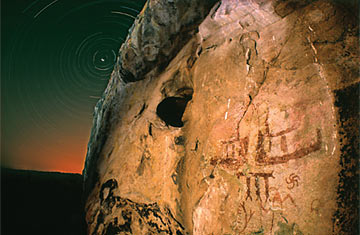
The counterclockwise rotation of stars around Polaris as viewed from Painted Rock in Carrizo Plain, Calif. The glyph on the "scorpion tree" appears to portray Ursa Major in relation to Polaris
Though local lore held that the so-called "scorpion tree" had been the work of cowboys, paleontologist Rex Saint Onge immediately knew that the tree was carved by Indians when he stumbled upon it in the fall of 2006. Located in a shady grove atop the Santa Lucia Mountains in San Luis Obispo County, the centuries-old gnarled oak had the image of a six-legged, lizard-like being meticulously scrawled into its trunk, the nearly three-foot-tall beast topped with a rectangular crown and two large spheres. "I was really the first one to come across it who understood that it was a Chumash motif," says Saint Onge, referring to the native people who painted similar designs on rock formations from San Luis Obispo south through Santa Barbara and into Malibu.
Amazingly, Saint Onge had just identified the West Coast's only known Native American arborglyph, one long hidden behind private property signs. But the discoveries didn't stop there. After spending more time at the site, Saint Onge realized that the carved crown and its relation to one of the spheres was strikingly similar to the way the constellation Ursa Major — which includes the Big Dipper — related to the position of Polaris, the North Star. "But as a paleontologist, I live my life looking down at the ground," says Saint Onge, who runs an archaeological-consulting firm out of nearby Arroyo Grande. "I didn't know much about astronomy at all."
He quickly learned that the constellation rotates around the North Star every 24 hours, that its placement during sunset could be used to tell the seasons and that the Chumash people also revered this astronomical relationship in their language and cosmology. "It's the third largest constellation in the sky and they saw it every single night for tens of thousands of years," says Saint Onge. "It was like the TV being stuck on the same channel playing the same show nonstop." It became increasingly obvious to Saint Onge that the arborglyph and related cave paintings weren't just the work of wild-eyed, drug-induced shamans — which has been a leading theory for decades — but that the ancient images were deliberate studies of the stars and served as integral components of the Chumash people's annual calendar. "This gives us an insight into what the indigenous people of Central California were doing," says Saint Onge, who published his theory last fall in the Journal of California and Great Basin Anthropology. "It wasn't just the daily simpleton tasks of hunter-gatherers. They were actually monitoring the stars."
Saint Onge isn't the first to speculate that Chumash paintings might have astronomical implications. The anthropologist Travis Hudson did so back in the 1970s with his book Crystals in the Sky, which combined his observations of rock art with the cultural data recorded nearly a century earlier by legendary ethnographer John P. Harrington. But when others went into the field to check out Hudson's claims, "much of it was pretty unconvincing," explains anthropologist John Johnson of the Santa Barbara Museum of Natural History. "That's what caused people to get skeptical about archaeoastronomical connections."
That reluctance ruled for three decades until Saint Onge presented his findings to Johnson, a bookish researcher who isn't one to rock the academic boat with unsubstantiated suggestions. But Johnson was so impressed that he co-authored the journal article and is now quite open to the idea that the rock art he's studied his whole adult life might have something to say about the stars. "Whether we're right or not, I don't know, but we keep finding things that strengthen the idea," says Johnson. "And if we keep finding ethnographic support for it, I feel we're on safer ground."
Neither man knows how long ago the tree was carved — though they speculate that a Chumash family that lived on a nearby hillside until they all died in the 1918 flu epidemic may have tended to the arborglyph as the bark and lichen grew back — but they're just relieved that Saint Onge was able to find it at all. "The upkeep of the motif itself has gone by the wayside and it's not long for the world," says Saint Onge, explaining that carpenter ants are attacking the limbs, "so I think it was a good thing that we came across it when we did."
Johnson and Saint Onge are most satisfied that the arborglyph is confirming what they've long known: that, despite centuries of being classified by historians as merely hunter-gatherers, the Chumash lived in a very complex and sophisticated society. Those sentiments are echoed loudly by Joe Talaugon, a 79-year-old Chumash elder who visited the site early on with Saint Onge and is also a co-author of the study. Although he says that the Chumash people's traditions were "stripped" by the Spanish mission system that ruled California 200 years ago, Talaugon believes that the arborglyph and its implications empower the ongoing cultural renaissance among those of Chumash descent. In recent years, Chumash revivalists have built and paddled plank canoes into the sea, developed a linguistic textbook and learned to perform the music and dancing of yesteryear.
"Chumash people are realizing that they do have a connection to their ancestors, so they want to renew that," says Talaugon, a retired construction worker who founded the Guadalupe Cultural Arts Center in northern Santa Barbara County to rejuvenate the Chumash culture and spiritual beliefs. "It's important to me as an elder that we tell the truth about our history," says Talaugon. "The tree carving opened up a lot of avenues to do so."
